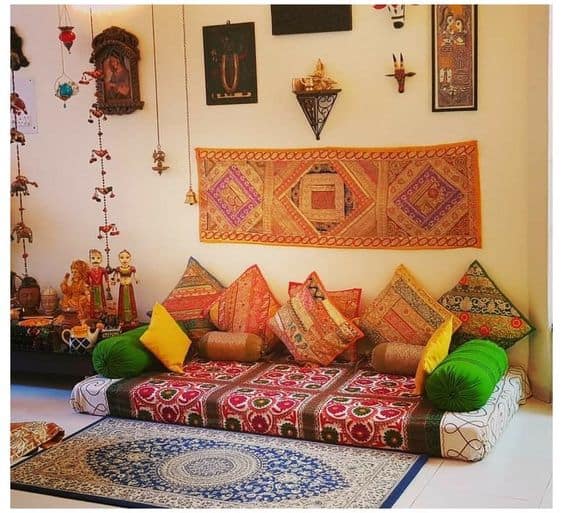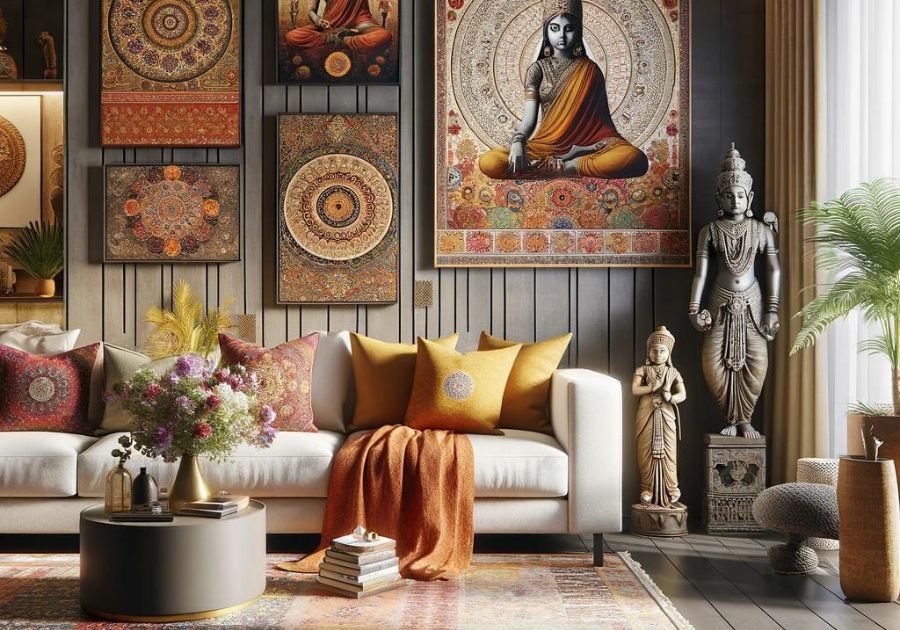Welcome to the vibrant world of traditional Indian decor! As someone who has immersed themselves in the rich tapestry of Indian culture, I am excited to share my insights and experiences with you. Traditional Indian decor is more than just aesthetics; it’s a story told through art, textiles, and craftsmanship that reflects the diverse heritage of this enchanting country.
Understanding Traditional Indian Decor
Before we delve into the details, let’s clarify what traditional Indian decor means. It encapsulates the art and practice of decorating spaces using elements that resonate with India’s history, culture, and artistic expressions. From the colorful patterns of handwoven rugs to the intricate carvings found in wooden furniture, each piece serves as a testament to India’s rich craft traditions.
The Cultural Significance of Indian Decor
Indian decor is deeply intertwined with the country’s festivals, rituals, and daily practices. Each region offers its unique style, materials, and motifs that hold cultural significance. Here are some key aspects to consider:
- Regional Diversity: India is home to various states, each with its distinct decor styles influenced by local traditions.
- Spiritual Elements: Many decor items have spiritual significance, including symbols and motifs that represent prosperity and well-being.
- Craftsmanship: The artistry involved in creating decor items reflects centuries of tradition and skill passed down through generations.

Elements of Traditional Indian Decor
Textiles: The Heart of Indian Decor

Textiles play a crucial role in traditional Indian decor. From bed linens to drapes, the choice of fabric can dramatically alter the ambiance of a space.
| Type of Textile | Description | Regional Origin |
|---|---|---|
| Silk | Luxurious fabric often used for sarees and upholstery. | Karnataka, Tamil Nadu |
| Cotton | Breathable fabric ideal for quilts and casual wear. | |
| Wool | Warm fabric used for carpets and blankets. | Jammu and Kashmir |
| Jute | Eco-friendly material used widely in home decor items. | West Bengal |

Furniture: A Blend of Functionality and Artistry
Traditional Indian furniture is often made from strong hardwoods, adorned with intricate carvings and inlays. Here are a few types of traditional Indian furniture:

- Chowki: A low wooden stool, perfect for seating or serving.
- Palki: A beautifully carved chair often seen in royal settings.
- Jaali work: A design element featuring lattice-like patterns, adding elegance to furniture.
Color Palette: Vibrancy Meets Serenity

The colors used in traditional Indian decor can uplift the mood of a room. Here are some popular colors:
- Red: Symbolizes passion and energy.
- Yellow: Represents joy and warmth.
- Green: Indicates prosperity and harmony.
- Blue: Signifies tranquility and calmness.

Art and Crafts: Storytelling in Decor
Art plays a significant role in traditional Indian decor. Various forms of art are integrated into home decor, such as:
- Madhubani Paintings: Intricate folk art that tells stories through its designs.
- Pattachitra: Traditional cloth-based scroll painting from Odisha.
- Miniature Paintings: Small, detailed artworks showcasing Indian culture.
How to Incorporate Traditional Indian Decor in Your Home
Infusing your home with elements of traditional Indian decor can create an inviting and culturally rich atmosphere. Here are some tips:
1. Start with Textiles
Adding textiles is one of the easiest ways to introduce traditional Indian decor into your home. Consider:
- Indian block-printed cushion covers.
- Brightly colored bedspreads or quilts.
- Flowy curtains made from silk or cotton.
2. Choose Statement Furniture
Investing in a few statement pieces can transform your space. Look for:
- A traditional wooden dining table with intricate carvings.
- Handcrafted wooden chairs or stools.
- Decorative side tables made from reclaimed wood.
3. Embrace Wall Art
Wall art can dramatically change the ambiance of a room:
- Hang a large Madhubani painting above your sofa.
- Use tapestries with traditional Indian patterns as wall hangings.
- Arrange a gallery wall featuring miniatures and other art forms.
4. Include Accessories and Decorative Items
Accessories add the finishing touches to a room. Consider:
- Brass or copper lamps for a vintage look.
- Hand-painted pottery for decorative accents.
- Traditional Indian sculptures or idols to enhance spiritual energy.
Pros and Cons of Traditional Indian Decor
Pros
- Rich cultural heritage that adds character to your home.
- Variety of styles and elements to choose from.
- Unique craftsmanship that showcases artistry.
- Vibrant colors can enhance mood and create warmth.
Cons
- May require more maintenance compared to modern decor.
- Can be expensive based on the craftsmanship involved.
- Finding authentic pieces may require extensive searching.
Comparison of Traditional and Modern Decor Styles
| Feature | Traditional Indian Decor | Modern Decor |
|---|---|---|
| Color Palette | Vibrant and rich colors | Neutral and minimalist tones |
| Materials | Wood, textiles, metals | Glass, metal, plastics |
| Patterns | Intricate, cultural motifs | Geometric and simple designs |
| Cultural Influence | Deeply rooted in heritage | Global influences and trends |
Incorporating Traditional Indian Decor into Various Spaces
Living Room
The living room can be a focal point of traditional decor. Consider including:
- A traditional low seating arrangement with cushions.
- Colorful rugs with intricate designs.
- Decorative items like brass lamps and wall art.
Bedroom
Creating a serene bedroom space can be achieved by:
- Using rich, warm textiles for bed linens.
- Opting for wooden furniture with carvings.
- Incorporating soft lighting through lanterns or chandeliers.
Kitchen
To infuse Indian decor in the kitchen:
- Use colorful ceramic pots for storage.
- Decorate the walls with traditional art or spice racks.
- Choose wooden cabinets with ornate handles.
Outdoor Spaces
Enhance your garden or balcony with:
- Terracotta pots and planters.
- A traditional swing or jhoola.
- Outdoor rugs for a cozy seating area.
FAQs About Traditional Indian Decor
What materials are commonly used in traditional Indian decor?
Common materials include wood, cotton, silk, brass, and terracotta. Each material brings its unique texture and aesthetic appeal.
How can I find authentic traditional Indian decor items?
Look for reputed local artisans, attend craft fairs, or shop at specialty stores that focus on handmade and artisanal products.
Is traditional Indian decor suitable for small spaces?
Absolutely! You can incorporate traditional elements by choosing smaller pieces, such as decorative items or textiles, without overwhelming the space.
Can I mix traditional Indian decor with modern elements?
Yes! Blending traditional and modern decor can create a unique and eclectic look, allowing you to express your personal style.
How do I maintain traditional Indian decor items?
Regular dusting and careful handling are essential. For textiles, follow care labels, while wooden pieces may need periodic polishing to retain their shine.
Conclusion
Traditional Indian decor offers a beautiful way to enrich your home with culture, art, and history. By understanding its elements and incorporating them thoughtfully, you can create a space that is not only visually appealing but also tells a story. Whether you are drawn to the vibrant colors of textiles, the intricate designs of furniture, or the spiritual significance of art, traditional Indian decor has something for everyone. Embrace this style, and let your home reflect the rich heritage of India!